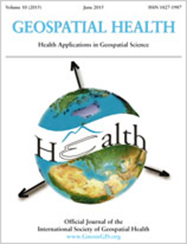Integrating agent-based disease, mobility and wastewater models for the study of the spread of communicable diseases

Published: 11 February 2025
Abstract Views: 1293
PDF: 324
Supplementary Materials: 218
HTML: 131
Supplementary Materials: 218
HTML: 131
Publisher's note
All claims expressed in this article are solely those of the authors and do not necessarily represent those of their affiliated organizations, or those of the publisher, the editors and the reviewers. Any product that may be evaluated in this article or claim that may be made by its manufacturer is not guaranteed or endorsed by the publisher.
All claims expressed in this article are solely those of the authors and do not necessarily represent those of their affiliated organizations, or those of the publisher, the editors and the reviewers. Any product that may be evaluated in this article or claim that may be made by its manufacturer is not guaranteed or endorsed by the publisher.
Similar Articles
- Wentao Yang, Fengjie Wang, Yihan You, Zhixiong Fang, Xing Wang, Xiaoming Mei, Optimizing vaccination sites for infectious diseases based on heterogeneous travel modes in multiple scenarios , Geospatial Health: Vol. 20 No. 1 (2025)
- Ana M. Vicedo-Cabrera, Annibale Biggeri, Laura Grisotto, Fabio Barbone, Dolores Catelan, A Bayesian kriging model for estimating residential exposure to air pollution of children living in a high-risk area in Italy , Geospatial Health: Vol. 8 No. 1 (2013)
- Rudi Cassini, Paolo Mulatti, Claudia Zanardello, Giulia Simonato, Manuela Signorini, Stefania Cazzin, Pier Giorgio Tambalo, Mario Cobianchi, Mario Pietrobelli, Gioia Capelli, Retrospective and spatial analysis tools for integrated surveillance of cystic echinococcosis and bovine cysticercosis in hypo-endemic areas , Geospatial Health: Vol. 8 No. 2 (2014)
- Beatriz Martínez-Lòpez, Tsviatko Alexandrov, Lina Mur, Fernando Sánchez-Vizcaíno, José M. Sánchez-Vizcaíno, Evaluation of the spatial patterns and risk factors, including backyard pigs, for classical swine fever occurrence in Bulgaria using a Bayesian model , Geospatial Health: Vol. 8 No. 2 (2014)
- Vitomir Djokić, Ivana Klun, Vincenzo Musella, Laura Rinaldi, Giuseppe Cringoli, Smaragda Sotiraki, Olgica Djurković-Djaković, Spatial epidemiology of Toxoplasma gondii infection in goats in Serbia , Geospatial Health: Vol. 8 No. 2 (2014)
- Jia-Cheng Zhang, Wen-Dong Liu, Qi Liang, Jian-Li Hu, Jessie Norris, Ying Wu, Chang-Jun Bao, Fen-Yang Tang, Peng Huang, Yang Zhao, Rong-Bin Yu, Ming-Hao Zhou, Hong-Bing Shen, Feng Chen, Zhi-Hang Peng, Spatial distribution and risk factors of influenza in Jiangsu province, China, based on geographical information system , Geospatial Health: Vol. 8 No. 2 (2014)
- Naoko Nihei, Osamu Komagata, Kan-ichiro Mochizuki, Mutsuo Kobayashi, Geospatial analysis of invasion of the Asian tiger mosquito Aedes albopictus: competition with Aedes japonicus japonicus in its northern limit area in Japan , Geospatial Health: Vol. 8 No. 2 (2014)
- Kuo-Hsin Tseng, Song Liang, Motomu Ibaraki, Hyongki Lee, C. K. Shum, Study of the variation of schistosomiasis risk in Lake Poyang in the People's Republic of China using multiple space-borne sensors for monitoring and modelling , Geospatial Health: Vol. 8 No. 2 (2014)
- Ulrik B. Pedersen, Nicholas Midzi, Takafira Mduluza, White Soko, Anna-Sofie Stensgaard, Birgitte J. Vennervald, Samson Mukaratirwa, Thomas K. Kristensen, Modelling spatial distribution of snails transmitting parasitic worms with importance to human and animal health and analysis of distributional changes in relation to climate , Geospatial Health: Vol. 8 No. 2 (2014)
- Mohammadreza Rajabi, Ali Mansourian, Petter Pilesjö, Ahad Bazmani, Environmental modelling of visceral leishmaniasis by susceptibility-mapping using neural networks: a case study in north-western Iran , Geospatial Health: Vol. 9 No. 1 (2014)
You may also start an advanced similarity search for this article.












